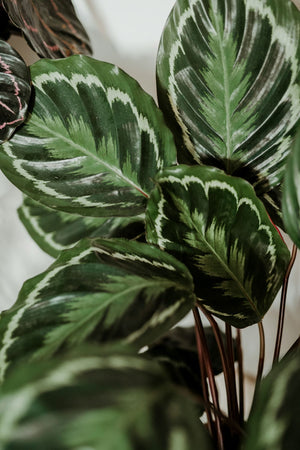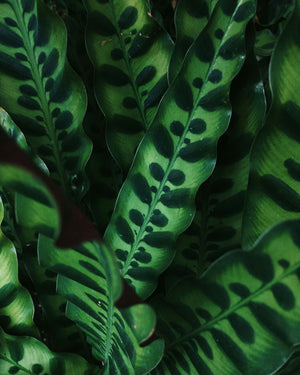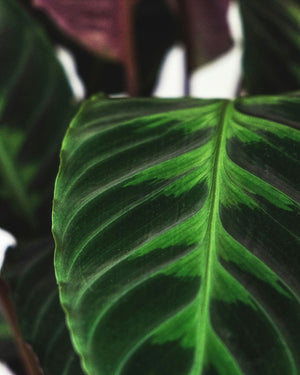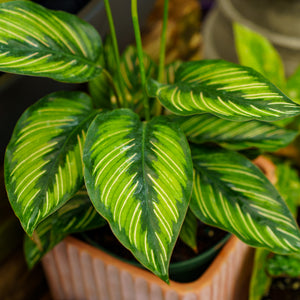The Calathea Guide
Calathea plants are celebrated for their exquisite foliage, marked by bold patterns and vibrant hues that bring a touch of the tropics indoors. Native to the rainforests of South America, Calatheas are members of the Marantaceae family and are commonly referred to as “prayer plants” for the way their leaves fold upward at night. With the right care, Calatheas make stunning additions to any home or office. Here’s everything you need to know about growing and caring for Calathea.

About
Calathea is a genus of ornamental foliage plants known for their dramatic leaf patterns, ranging from stripes and spots to feather-like veins and vibrant green, purple, or silver coloring. These plants thrive in warm, humid environments and are grown primarily for their foliage, as flowers are rare in indoor conditions.
Popular varieties include Calathea zebrina, with its striking zebra-striped leaves; Calathea makoyana (Peacock Plant), known for its eye-catching, feathery patterns; and Calathea concinna 'Freddie', a compact variety with soft green, wavy stripes. Calathea ornata 'Beauty Star' and Calathea elliptica 'Vittata' feature contrasting pinstripes that shine in bright, indirect light, while Calathea rufibarba 'Tropistar' adds texture with velvety, ruffled leaves.
These plants are ideal for low-light conditions and add life and movement to indoor spaces with their leaf-folding habit. Though they can be finicky about care, their ornamental value makes the extra attention worthwhile.

PLANTING
- USDA Hardiness Zones (Indoors): Suitable for year-round indoor growth in all zones.
- Soil: Use a rich, well-draining potting mix with added peat moss or coco coir. Ensure good aeration and drainage.
- Containers: Choose a pot with drainage holes to prevent water accumulation. Plastic or glazed ceramic pots retain moisture better.
- Sunlight: Prefers bright, indirect light. Avoid direct sun, which can scorch the leaves. Tolerates low light, though leaf patterns may fade slightly.
- Planting Time: Can be planted or repotted year-round, but spring is ideal to coincide with the growing season.
To plant or repot, gently loosen the roots, refresh the soil, and place the plant so that the crown is just above the soil line. Water thoroughly after repotting.

CARE
- Watering: Keep the soil evenly moist but not soggy. Water when the top inch of soil feels dry. Use filtered or distilled water to avoid leaf browning caused by tap water salts.
- Humidity: High humidity is essential. Aim for 50% or higher. Use a humidifier, pebble tray, or misting to increase ambient moisture.
- Temperature: Maintain a consistent temperature between 65–80°F. Avoid cold drafts and sudden changes.
- Fertilizing: Feed monthly during the growing season (spring through summer) with a diluted, balanced liquid fertilizer.
- Pruning: Remove any yellow or damaged leaves to encourage healthy growth. Wipe leaves occasionally to remove dust.
- Repotting: Repot every 1-2 years or when the plant outgrows its container.

HOW TO USE
Calathea’s bold foliage and elegant form make it a popular choice for interior décor:
- Houseplant Collections: Adds texture and color variety alongside other tropical plants.
- Low-Light Corners: Ideal for spots away from direct sun, such as hallways, bedrooms, or bathrooms.
- Containers & Planters: Display in decorative pots that complement their leaf colors and patterns.
- Office Décor: Brings a calming, natural touch to indoor workspaces with adequate humidity.
- Standalone Specimens: Larger varieties like Calathea 'Maui Queen' or Calathea burle-marxii make stunning focal points.

Common Questions
- Are Calathea plants toxic to cats? No, Calathea plants are non-toxic to cats and safe for pet-friendly homes.
- Are Calathea plants toxic to dogs? No, Calatheas are also safe for dogs and pose no known toxicity risk.
- How to care for Calathea? Provide bright, indirect light, maintain high humidity, water with filtered water, and avoid temperature fluctuations.
- How to save a dying Calathea plant? Trim damaged leaves, ensure proper watering, increase humidity, and repot if the roots are compacted or rotting.
- How to propagate Calathea? Divide during repotting in spring. Separate rooted clumps and pot them in fresh soil.
- How often to water Calathea? Water when the top inch of soil is dry. Typically every 5–7 days, depending on environment.
- Are Calathea plants easy to care for? Calathea requires consistent care and humidity, but once established, it adapts well to indoor conditions with regular attention.
Conclusion
Calathea plants offer exotic foliage, soothing movement, and a tropical vibe that’s hard to match. Whether you’re drawn to the bold stripes of Calathea zebrina or the delicate feathering of Calathea makoyana, these plants make beautiful, pet-safe additions to any indoor collection. With the right humidity, lighting, and care, Calatheas will reward you with vibrant growth and year-round visual appeal. Explore our collection to find the perfect Calathea for your home.
The Calathea Collection
Sold Out
Sold Out
Sold Out
Sold Out
Sold Out






